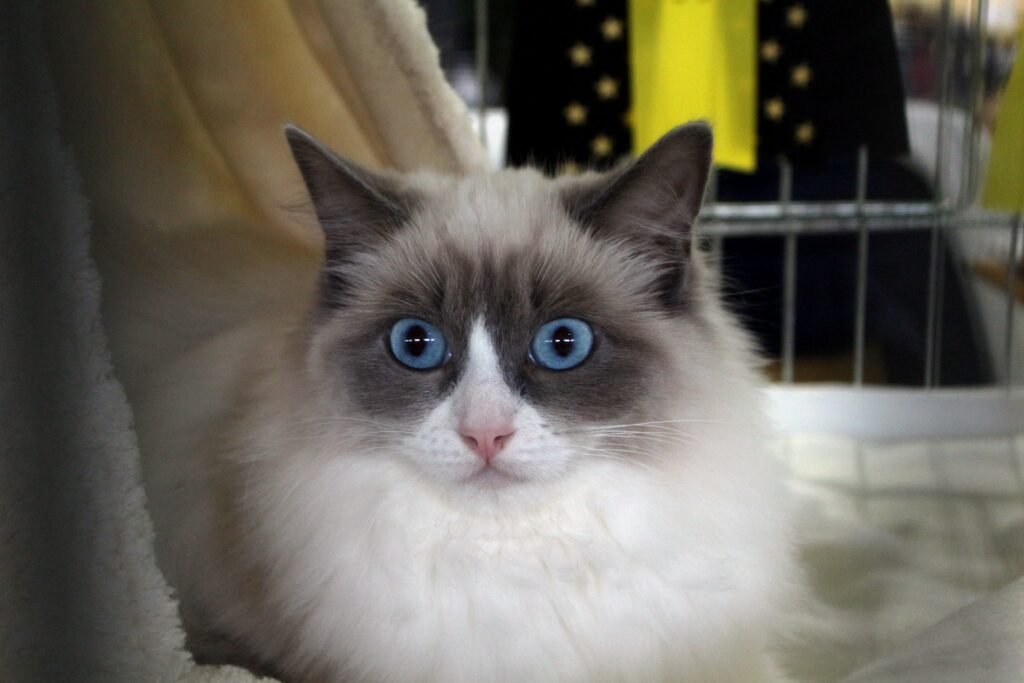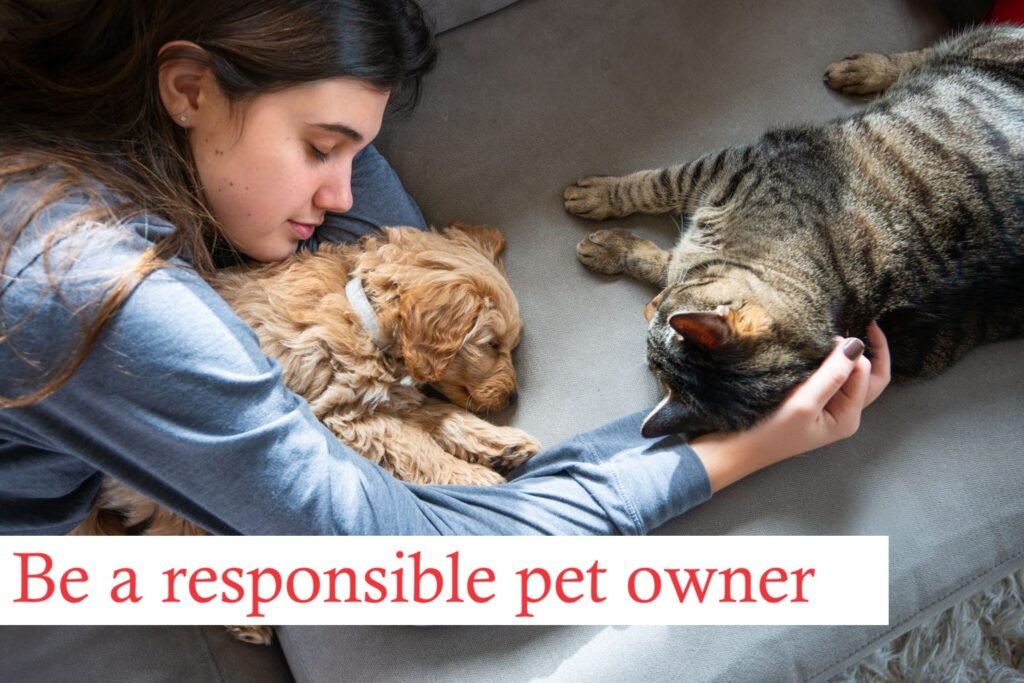In the world of pet care, Ragdoll cats are one of the most loved and unique cat breeds. They are famous for their big blue eyes, large size, and soft fur. Their unique charm makes them popular among cat lovers. The name “Ragdoll” comes from their habit of going limp and relaxed when picked up, like a child’s ragdoll toy.
This guide will examine Ragdoll cats’ history, looks, personality, care needs, and common health issues. This will give future owners the necessary information to understand and care for these beautiful cats.
| Characteristic | Comprehensive Details |
| Size & Weight | Large |
| Coat Type | Semi-long, Silky, Dense, Plush |
| Coat Colors | Pointed (seal, chocolate, blue, lilac, red, cream). |
| Patterns | Colorpoint, Mitted, Bicolor. |
| Eye Color | Large, Round blue eyes |
| Temperament | Gentle, affectionate, docile, puppy-like behavior |
| Body Structure | Muscular, Broad chest, Large paws. |
| Health Concerns | Prone to HCM, Bladder stones, and Obesity. |
| Life Expectancy | 12-15 years with proper care and vet check-ups. |
A Brief History of the Ragdoll Breed
The Ragdoll breed began in Riverside, California, in the 1960s. Ann Baker, who created the breed, started with a white long-haired cat named Josephine. Josephine’s kittens were very gentle and loving. Ann Baker bred these cats to keep these traits, creating the Ragdoll breed. She trademarked “Ragdoll” and set up the International Ragdoll Cat Association (IRCA) to maintain high breeding standards. Over time, major cat registries recognized the breed, and now Ragdoll cats are one of the most popular cat breeds in the world.
Physical Characteristics
Size and Weight
Ragdoll cats are one of the most giant domestic cat breeds. Adult females typically weigh between 8 and 15 pounds (3.6 and 6.8 kg), while males are larger, ranging from 12 to 20 pounds (5.4 to 9.1 kg) or more. Ragdolls can take up to four years to reach their full size.
| Feature/Gender | Range |
| Weight (Male) | 10 – 20 lbs (4.5 – 9 kg) |
| Weight (Female) | 10 – 20 lbs (4.5 – 9 kg) |
| Height | 9 – 11 inches (23 – 28 cm) |
| Length | 17 – 21 inches (43 – 53 cm) |
Coat and Color
Ragdolls have a silky, semi-long coat that needs regular grooming to stay in good condition. They are known for their pointed coloration, where the body is lighter than the face, ears, legs, and tail. Ragdolls come in six primary colors: seal, chocolate, red, blue, lilac, and cream. All colors have lynx and tortoiseshell variations. They display three primary patterns: Colorpoint, mitted (with white paws and sometimes a belly stripe), and bicolor (with white legs and an inverted V on the face).
Eyes Shape and Color
Large, round blue eyes distinguish ragdolls. Their coat pattern genetics link this blue color to deeper shades of blue, which are highly prized in cat shows.
Temperament and Behavior of Ragdoll
Ragdolls are famous for being gentle and loving. People often refer to ragdolls as “puppies-like” because they follow their owners and enjoy cuddles. Their friendly nature makes them ideal for families with kids and other pets.
Affectionate and Social
Ragdolls love being around people and being part of the family. They often greet their owners warmly and love cuddling in laps. They’re relaxed and friendly, making them perfect companions for everyone.
Playful and Smart
Though not super energetic, Ragdolls like playing and can be very playful, especially when young. They’re intelligent cats that can learn tricks like fetching toys. Playing with them keeps them happy and stops them from getting bored.
Quiet
Ragdolls are generally quiet cats with soft voices. They’re not known for making much noise, which is great if you prefer a calmer pet.
How to Ensure Your Ragdoll Cat Stays Healthy
Grooming Tips
Ragdolls have long, silky fur but need less grooming than other long-haired cats. They don’t have a thick undercoat, so they shed less and have fewer mats. Brushing their coats at least twice a week helps to keep them healthy and reduce shedding.
- Brushing: Use a wide-toothed comb or soft brush to remove loose hair and prevent tangles.
- Bathing: Sometimes, they might need a bath, especially if they get dirty. Use shampoo made for cats and rinse well.
- Nail Trimming: To prevent your nails from growing too long, trim them regularly.
- Ear Cleaning: Frequently check their ears for dirt, wax, or signs of infection. If needed, use a vet-approved ear cleaner.
| Grooming Task | Frequency | Tools/Products |
| Brushing | Twice a week | Wide-toothed comb, soft-bristle brush |
| Bathing | Occasional | Cat-specific shampoo |
| Nail Trimming | Regular | Cat nail clippers |
| Ear Cleaning | As needed | Vet-approved ear cleaner |
Diet and Nutrition
A balanced diet is important for keeping a Ragdoll cat healthy. It’s best to use high-quality cat food that gives them all the necessary nutrients. It’s important to monitor their weight, as Ragdolls are prone to obesity.
- Wet Food vs. Dry Food: Wet food can add extra moisture and help prevent bladder problems. But it’s good to mix wet and dry food for a balanced diet.
- Portion Control: Measure their food to ensure they don’t overeat and stay at a healthy weight.
- Fresh Water: Always have fresh water available. Some Ragdolls like running water, so a cat water fountain can be helpful.
- Treats: Give treats in moderation and choose ones that aren’t high in calories to prevent them from gaining too much weight.
Exercise and Enrichment
Even though Ragdolls aren’t very energetic, it’s important to play with them regularly and keep their minds active to keep them happy and healthy.
- Interactive Toys: Give them different toys like feather wands, laser pointers, and puzzle feeders.
- Climbing Structures: Cat trees and shelves let them climb and explore.
- Social Time: Spend time with your Ragdoll to bond and keep them mentally active.
- Enrichment: To keep them interested, change their toys frequently and introduce new activities.
Common Health Issues in Ragdoll Pet Cats
Hypertrophic Cardiomyopathy (HCM)
Ragdolls have a common heart problem called hypertrophic cardiomyopathy, which occurs when the heart muscle thickens. Genetic testing can identify cats at risk due to this inherited condition. Regular vet check-ups are important to catch and manage hypertrophic cardiomyopathy early.
- Symptoms: Signs may include feeling tired, fast breathing, and not wanting to eat.
- Treatment: There’s no cure, but medicine and lifestyle changes can help.
Bladder Stones
Ragdolls can get bladder stones, which cause discomfort and trouble with peeing. Straining to urinate, having blood in the urine, and making noise in the litter box are all signs of bladder stones. Drinking enough water and having a balanced diet can help prevent this problem.
- Symptoms: Signs include frequent peeing, difficulty peeing, and bloody peeing.
- Treatment: Treatment might consist of diet changes, medicine, or surgery.
Obesity Disease
Because they’re big and not very active, Ragdolls can become overweight. To maintain their healthy weight, it’s crucial to monitor their diet, provide them with regular exercise, and avoid overindulging in treats.
- Prevention: Regular play and a balanced diet are important to prevent obesity.
- Management: If your cat gets too heavy, ask your vet for a plan to help them lose weight.
Feline Infectious Peritonitis (FIP)
FIP is a viral disease that can affect ragdolls and other cat breeds. A modified form of the cat coronavirus causes FIP, which can be challenging to diagnose and treat. Early signs include fever, weight loss, and feeling tired. There’s no definite cure, but supportive care can help manage the signs.
- Symptoms: Signs are different but often include losing weight, fever, and tiredness.
- Treatment: While there’s no cure, supportive care can improve their life quality.
Lifespan and Quality of Life
Ragdoll cats usually live for 10 to 15 years, but some can live longer with good care. Regular visits to the vet, a balanced diet, and a healthy lifestyle can help your Ragdoll live a longer, happier life.
- Veterinary Care: Regular check-ups are essential to catch and treat health problems early.
- Dental Health: Regular dental check-ups and cleanings help prevent dental issues.
- Vaccinations: Make sure your cat gets all the necessary vaccinations to stay protected from common cat illnesses.
Socialization and Training
Early Socialization
It’s essential to help your Ragdoll kitten become confident and comfortable around people and different places early on.
- Handling: Gently hold and touch your kitten to help them get used to it.
- Positive Experiences: Positively introduce your kitten to new people and places.
Litter Training
Ragdolls usually learn to use the litter box easily. Start training your kitten as soon as they come home.
- Litter Box: Keep a clean and easy-to-reach litter box for your kitten.
- Positive Reinforcement: Praise or treat your kitten when they use the litter box correctly.
Behavioral Training
Ragdolls are intelligent and can learn simple tricks and commands. Use treats and praise to encourage good behavior.
- Basic Commands: Teach your cat simple commands such as “sit,” “stay,” and “come.”
- Enrichment Activities: Keep your cat’s mind active with playtime and puzzle toys.
Living Standard of Ragdoll Pet Cat
Home Environment
Ragdolls can live comfortably in different homes, from apartments to large houses. Safety: Make sure your home is safe and free of dangers. Secure windows and balconies. Space: Give your Ragdoll enough room to move around and explore.
Compatibility with Other Pets
Ragdolls are friendly and get along well with other pets, such as dogs and cats. Introduction: Introduce new pets slowly and watch how they interact. Supervision: Monitor their interactions for safety and positivity.
Where can you adopt or purchase a Ragdoll?
From Breeders
If you want to add a Ragdoll to your family, you have a few options for finding a good source.
- Breeders: Reputable breeders follow ethical breeding practices and care about their cats’ health. When selecting a breeder, it’s crucial to seek out someone who:
- The system provides health records and genetic test results.
- Let’s go to their house and meet the kittens and their parents.
- Has a wealth of knowledge about the breed and responds to your inquiries.
- The company offers a written health guarantee and contract.
- The cost of a ragdoll kitten can range from $400 to $2500, depending on its pedigree, color, and pattern.
Adoption From a Shelter
Adopting a Ragdoll cats from a shelter or rescue organization is a great choice. Many rescues specialize in Ragdolls; local animal shelters often have them up for adoption. Adoption fees are typically lower than buying from a breeder, and they cover initial vet care.
- Shelters: Check local ragdoll shelters and rescues that are available for adoption.
- Rescue Groups: Look for Ragdoll-specific rescue groups that focus on finding new homes for these cats.
Final Thought
Ragdoll cats are known for their loving nature and beautiful blue eyes. Originally from California, they make great pets for families. Regular grooming, good food, and health check-ups keep them healthy. Ragdoll cats need a stable and caring home where they get attention. If you’re thinking about getting one or already have one, make sure they have a safe and cozy place to live. Learn more about Ragdoll cats and give them the love and care they need to be happy.



